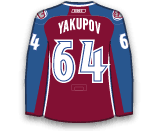It looked as if Brian Gionta was going to return to the lineup on Monday which would have forced Reinhart out, but GIonta will sit for the third consecutive game, which means Reinhart should stay in the lineup.

It looked as if Brian Gionta was going to return to the lineup on Monday which would have forced Reinhart out, but GIonta will sit for the third consecutive game, which means Reinhart should stay in the lineup.

Yakupov finished Saturday’s game on the Oilers’ second line with Connor McDavid and Benoit Pouliot and in practice on Monday he found himself there again. Yakupov has had a rough time cracking the Oilers’ top six, but if he starts producing on a line with McDavid, look out.

McIlrath will replace Dan Boyle in the Rangers’ lineup on Tuesday. The 23-year-old blueliner had six goals and 11 assists (17 points) in 73 games with Hartford (AHL) last season but has yet to record a point in three NHL games. Look for him to skate alongside Keith Yandle.

Boyle had one assist and a plus-2 rating in Saturday’s win over the Rangers, but head coach Alain Vigneault obviously wants more out of Boyle, especially in the defensive zone, so he will sit tomorrow vs. Winnipeg.

Schenn was a minus-3 in the Flyers 7-1 blowout loss to the Panthers on Saturday, so it is no surprise to see him come out tonight. He will be replaced by Radko Gudas, who will be making his Flyers debut.

Gudas missed 51 games a season ago after undergoing knee surgery and now 225 days after being acquired from Tampa Bay, Gudas will finally make his Flyers debut. Gudas is a rugged defenseman, who Flyers fans should love as long as he can stay in the lineup. He isn’t really known for his offence having registered just 32 points (7G / 25A) in 126 games in his career.

Gagner, 26, was a healthy scratch in the first two games of the season, but with R.J Umberger out with an upper-body injury, Gagner will be inserted into the lineup for Monday’s clash with the Panthers. Gagner is coming off of a season where he had 15 goals and 26 assists (41 points) in 81 games.

Reinhart registered one assist and two shots on goal while averaging just 10:58 TOI in the first two games of the regular season, but with Brian Gionta on pace to return to the lineup tomorrow, it looks like Reinhart may sit. He skated as the extra forward, working in and out on lines during Sunday’s practice which suggests that he will be out vs. Columbus.

Brad Marchand sufferd a concussion on Saturday night and is out indefinitely. Marchand’s injury leaves a hole on the Bruins’ top line, which Connolly filled in Sunday’s practice. Connolly has no points and a minus-4 rating through the first two games of the season.

Miller, 22, came over in the Milan Lucic trade this summer and will make his NHL debut tonight vs. the Canadiens. Miller has a tonne of offensive ability on the blueline—he had 19 goals and 33 assists (52 points) in 70 games with Manchester (AHL) last season.

Brickley, 23, was the Panthers second round pick (50th overall) in 2010. The University of Vermont product had 22 goals and 25 assists (47 points) in 73 games with San Antonio (AHL) last season. He is expected to open the season on the Panthers’ fourth line.

After sitting out the season opener on Wednesday, McNabb is expected to replace Matt Greene in the lineup tonight vs. the Coyotes. McNabb had 24 points (2G / 22A) in 71 games with the Kings last season.

Weal, 23, is expected to replace Andy Andreoff in the Kings’ lineup on Friday. The 2010 third round pick (70th overall) had 20 goals and 49 assists (69 points) in 73 games with Manchester (AHL) last season.

Baun had one shot in 9:23 TOI in the Blackhawks’ season opener but it looks like he will sit in favour of Viktor Tikhonov.

It looks like Tikhonov will replace Kyle Baun in the Blackhawks starting lineup on Friday. Tikhonov skated in Baun’s spot on the Blackhawks’ third line with Andrew Shaw and Bryan Bickell. The former first round pick of the Coyotes, had 24 points (8G / 16A) in 49 games in the KHL last season.

Svedberg, 24, is a monster. At 6-foot-9, 235 lbs. he rivals Zdeno Chara for the tallest player in the NHL. Svedberg had a strong training camp and is expected to replace David Rundblad on Friday. He had three goals and 11 assists (14 points) in 49 games with Rockford (AHL) last season.

Grigorenko was acquired from the Sabres in the Ryan O’Reilly trade this summer, but he will be a healthy scratch in his first game with his new team. The 21-year-old has a tonne of potential but has had a difficult time getting his NHL career off of the ground.

Gudas had been skating among the Flyers’ top six defensemen throughout the week, but he will be scratched in the opener and Luke Schenn will play.

Byron was claimed off of waivers on Tuesday, but will be held out of the lineup for the season opener vs. the Maple Leafs.

A few days before the Sharks season gets underway, the 23-year-old Donskoi found himself skating on a line with Joe Thornton and Joe Pavelski. Donkoi has spent the last six years playing with Karpat of the Finnish league before signing with the Sharks. Last season he led Karpat with 49 points (19G / 30A) in 58 games—12 more points than second on the team.
